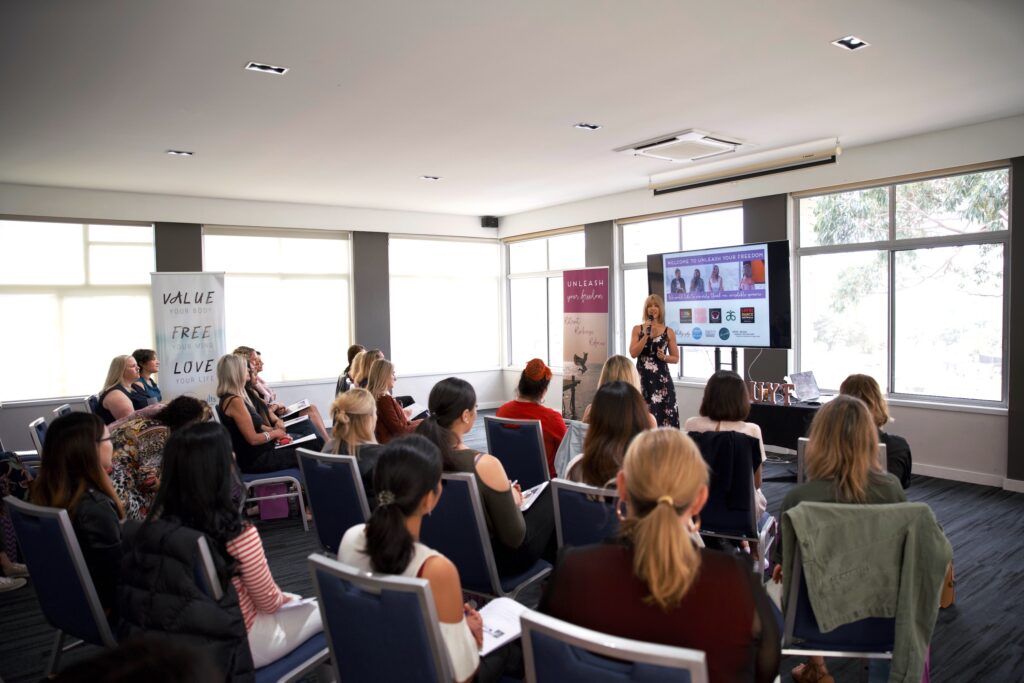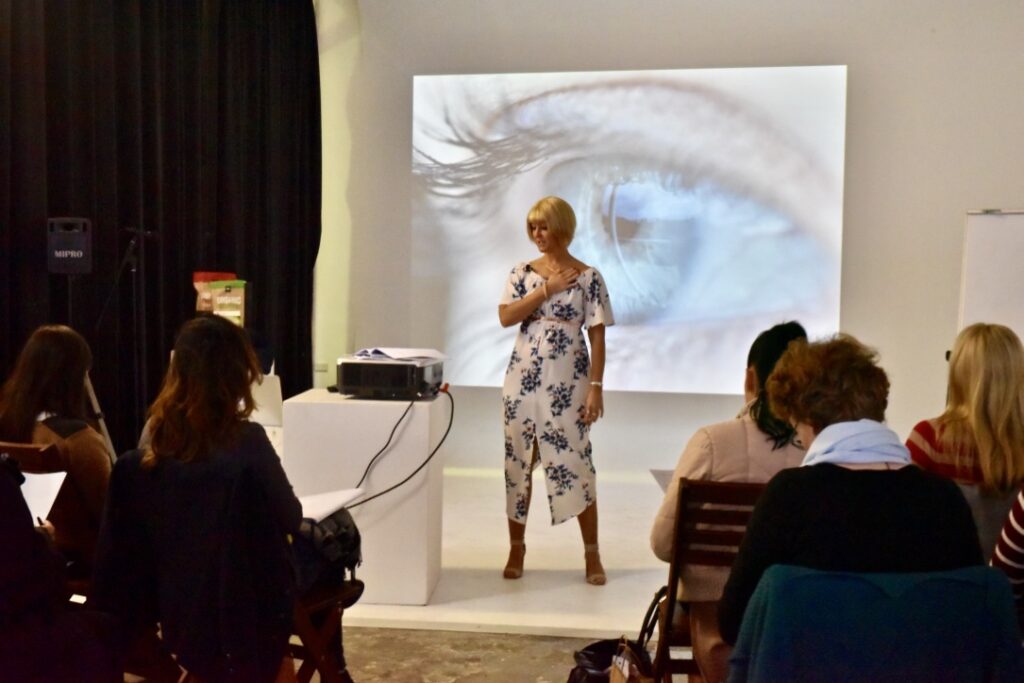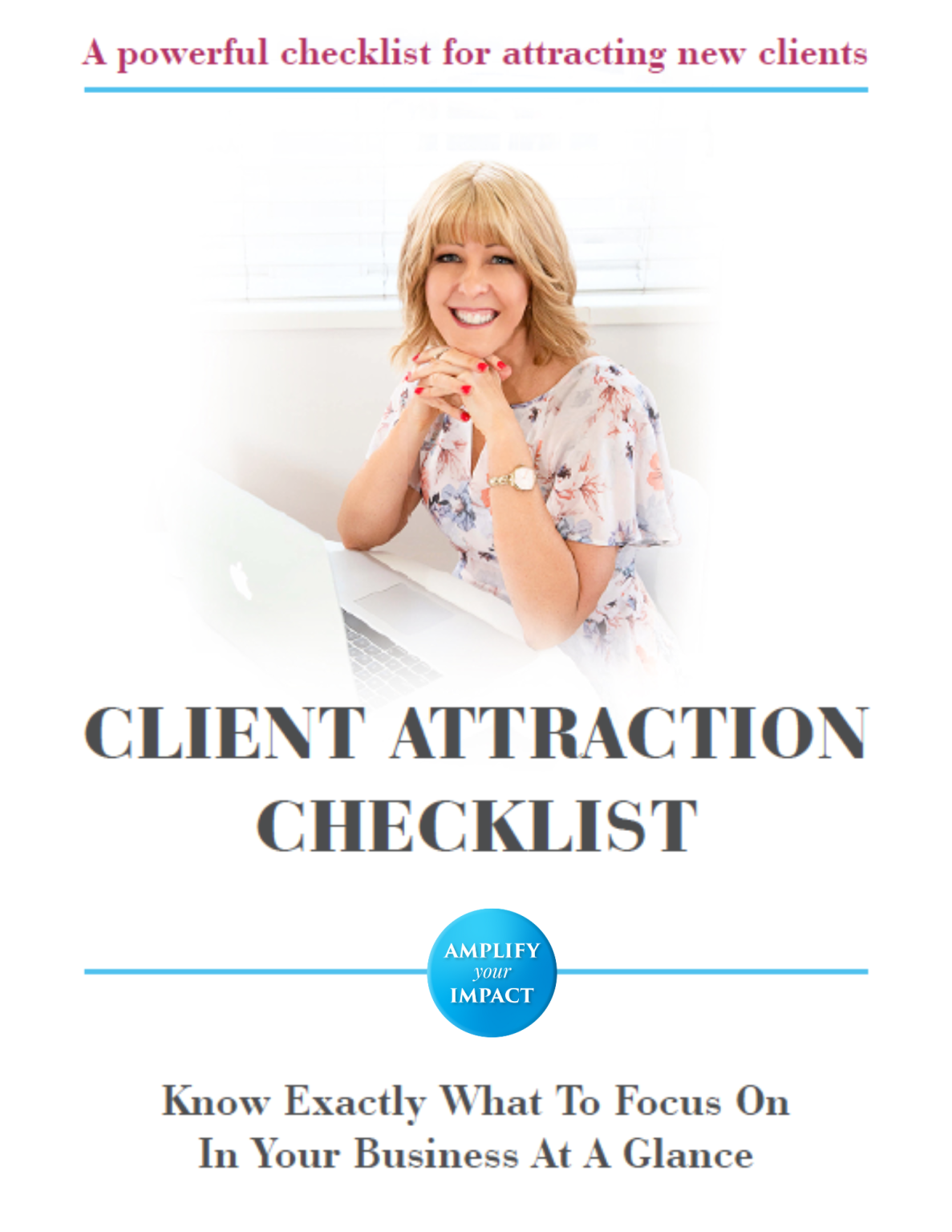Have you ever wondered what it takes to put together a successful presentation?
A presentation could be anything from a Facebook Live, a webinar, a workshop or even a video.
Over the last 10+ years, I’ve run over 200 events, both live, in-person and online, and I’ve discovered that when it comes to creating successful presentations, there are a few fundamental things that every single presentation should have.
In this video and blog, I share five main ingredients that make up a presentation that not only ensures your audience learns what you have to share….
But it also guarantees that they are engaged, maintain attention, and take ACTION on your content. ?

1 – Appeal To Every Type Of Learner
The first thing you do when is appeal to every type of learner. There are many ways that people learn and different ways that people process information.
The most important thing to keep in mind is that everybody who shows up and listens to your presentation learns in a different way.
There are four overarching core strategies, which are really four learning styles. And a lot of people just teach in their own learning style, instead of actually covering all four of these learning styles.
Learning Style 1 – People Learn Based On Their Personal Values
There are people out there that like to learn based on their personal values. So they really want to learn what’s important to them and what’s aligned to their highest values.
I call them the ‘why’ learner. They need to know why. Why am I learning this? And they need to know that very fast. If we don’t appeal to what’s important to them, they’re just going to switch off really fast. So we need to be able to start talking about the benefits and why very quickly for these types of learners.
Learning Style 2 – Use Statistics, Research, Evidence, Data And Facts
People learn differently. There are some that need to know the origin of things, proof evidence, data and facts. All of these are very left-brain types of information.
These types of learners are people who want you to have evidence to back up what you’re saying. They like to hear numbers, have data and they like analyse it. They like to know how things work and the proof to back it up.
Learning Style 3 – Describe How Things Work
The third way that people like to learn is to understand how things actually work. What are the mechanics? How do I actually put it into action? They want to be told so they can understand the benefits and reasons it aligns to their values.
We need to have a structure in our presentations that takes people through a process. We cannot just throw random information at people, it’s got to be organised. The most successful people have organised knowledge.
If you are teaching someone how to cook a beautiful cake, you have organised your knowledge around the recipe for this cake. You have the ingredients in order and then you give the method.
These learners learn best when you’ve really organised your information and structured it in a way that makes sense.
Learning Style 4 – Getting The Information, Tweaking It and Breaking It Down
Were you one of those kids that liked to take things apart and see if you could put it back together? This learning style is really lateral. These people are creative and think outside of the box.
They want to get information, break it down, refine it and tweak it. They are taking information and evolving it.
If you have people in your presentation that have this learning style, then you want to make sure that you’re enabling them to think about what is you know and then also think outside the box.
Remember to speak the way people talk and this will be a real game-changer for you in your presentations.
2 – Move Your Audience

Secondly, you need to be able to move your audience. Moving your audience is not about telling them what to do.
Just telling your audience step one, step two, step three etc doesn’t move them. We move people by tapping into their values, moving them emotionally, using stories, moving them down a process of inspiration and influence to actually take action.
You move people by understanding the pain they’re in and their existing problems by getting to know them. By getting clear on who your ideal clients are by building relationships with them through conversations, messages, surveys and free sessions.
A presentation is not just for someone to get more information. That’s not it. If you just deliver a presentation that gives people information, then they could have just googled it.
A presentation that moves you for example is a TED talk. They have empowering, motivational and inspiring speakers. These speakers are not just giving you facts or information, they’re moving you emotionally.
Deep down in specific parts of our brain, there’s a little child inside of us that just loves to hear stories. If those stories are structured in a way that we get value from a content perspective but we also enjoy the story itself, that is actually what keeps engagement.
The reason story telling is so effective is because when you tell a story to somebody and you clearly describe the characters in the story, as in you bring those characters to life inside that person’s imagination, our brain can’t help but produce small doses of Oxytocin.
Oxytocin is a bonding chemical. So if Oxytocin allows us to bond with things, then if I’m telling stories in my presentation and you’re releasing small amounts of Oxytocin, then the good news is you are bonding to what I am saying. And that means you’re paying close attention to what is being said.
One of the best ways you move people emotionally is through being vulnerable and showing your struggles and humility, and how you overcame your struggles.
You want to show people how you’ve gone from a vulnerable place of not knowing what to do, to a place of victory. It’s showing people that you were in a hard place, but you’ve been able to get out that inspires people.
3 – Provide Value
The next essential ingredient of a successful presentation is to provide value.
So, what exactly is value? Value is something that helps someone improve their life.
If someone is speaking about your highest values, then you’re going to give them your attention and enjoy what they’re saying.
If someone is not speaking about something that you value, then you will not give them your attention.
You tap into people’s values by talking about the things that they are most interested in, not just random information. Value is only valuable if you understand the problem that precedes it.
If you’re selling the most incredible recipe for the most amazing cake, and you’re trying to sell it to someone who’s gluten and dairy-free, but your recipe has flour and butter in it, then it’s not going to be of value to the gluten and dairy-free person.
I know it sounds overly simple. But if you think about this analogy, the value you give is only valuable if it solves a problem for someone. So we’ve got to know our audience.
I would never give a presentation unless I knew my audience. What are their biggest pain points? A lot of people just show up and present and don’t take the time to work out if what they are speaking on applies to a specific person with a specific problem.
Your presentation will only be a successful presentation if you are giving value, based on your audience’s highest values. If someone comes along and they give you content that’s way down on your priority list, then you’ve got all these priorities above it.
Value is all about helping people solve their highest priorities. And we do that by understanding our audience.
Whenever I give a live presentation, or if I give a keynote talk, I always survey the people I will be talking to. This is so I can understand what they are struggling with.
I get to know their biggest pain points, their desires and dreams. This way I can structure my content and give them the value they need.
4 – Use A Combination of Left And Right Brain Hemispheres

Our brains have left and right hemispheres, and we need to tap into these when we do a presentation.
The left brain is more logical and analytical and uses processes and sequences. Our right brain is creative and emotional. It uses symbolism, shapes, colours, feelings and emotions.
I learned from Brian Tracy, who is a great public speaker, about a concept called the windscreen wiper technique which uses the left side of the brain, then the right side of the brain when giving presentations.
A typical left-brained job is an IT specialist or an accountant dealing with numbers. A typical right-brained job is a writer, artist, singer painter or someone who thinks outside the box.
An audience is usually 50/50 – half are left-brained and half are predominantly right-brained. When we use the wiper and the left brain, right brain technique, we help our audience understand the concepts we are talking about in a way they will understand.
An example of this is if you’re jumping on a Facebook Live, you have to ask yourself, how can you include in your presentation a combination of story and emotion, but back them up with logic, facts and statistics.
It’s important to build out the side that you don’t naturally fit into. If you’re more of a logical person who has spent 40 hours that week in logical, analytical tasks, then you might think about how you can add in emotion and visuals to your presentation.
Think about how you can use visuals, diagrams and how you can use your hands to create visual representations when you are presenting.
If you’re using PowerPoints, you definitely want to use diagrams, visuals, analogies that bring things to life through story and metaphors.
In this blog, I’m using the metaphor of the recipe of the cake throughout this presentation. So I’m going back and forth from the logical by giving you the steps in order, but also weaving in this story and an analogy and metaphor of a cake recipe.
5- Break Down Advanced Concepts Into Frameworks & Simple Language
If you want to be successful when you present, you want to hone the ability to take really tough, complex, hard things, and teach them in a really simple way that people understand.
Helping your audience to understand your ideas using frameworks helps your content stick & be easier to understand and action. ? This takes crafting.
I remember hearing a story where a guy asked someone to speak at their summit. He asked the guy how long would it take for him to prepare.
The guy replied, “Well, that depends how long you want me to speak for. If you want me to speak for five minutes, then I’ll need probably a week to prepare. If you want me to speak for 10 minutes, I’ll only need a few days to prepare. If you want me to speak for half an hour, I probably will need a day to prepare.”
This goes against logic, right? We think the longer the presentation, the more time we need to prepare, but it’s actually the opposite. In order to condense information into smaller parts and make it really simple to understand, it takes more time.
It’s one of the hardest things to do. Anyone can just show up and regurgitate a whole lot of information. But to strip it down and teach it in simple concepts, takes time.
To do this you need to know your subject really well. An old mentor of mine spoke to me about using spots as a concept. She talked about the concept of sharing in spots, which is breaking down complex information into something that is more simple to understand.
An example of this is if you’re a health coach, and you wanted to do a presentation on three ways to improve your sleep. You wouldn’t just do the simple things that people know, like turn off your electronic gadgets half an hour before you sleep.
You would want to speak on something more complex, like understanding why your system is disrupted when there is electric magnetic fields in your bedroom. You want to inspire people to actually turn the electronics off before bed.
So it’s not a case of just telling people what to do. It’s actually taking some kind of complex piece of content and making it really simple to understand, that actually inspires someone to take action.
Whether you’re doing a Facebook Live, a webinar or workshop, or speaking on someone else’s podcast or group, remember the purpose of any presentation is to get people to take action.
If you’d like to learn how to create an event that inspires incredible action from your participants, I’d like to invite you to my upcoming FREE live workshop “How to Get Clients With Online Events”
I’ll be revealing my step-by-step method to using events to educate, engage and inspire people to take action, so you can grow your business and help more people.
You’ll learn how to:
* Use FREE events to reach your financial goals & a lifestyle of freedom
* Grow your business by helping more people using my proven formula
* Build trust and connection fast, even if you struggle with nerves …
* Create engaging and profitable presentations
* Position yourself as an expert in your niche
* Consistently sell out your programs
You can learn more about the event or claim your complimentary ticket here

See you soon!
Kat

Leave a Reply